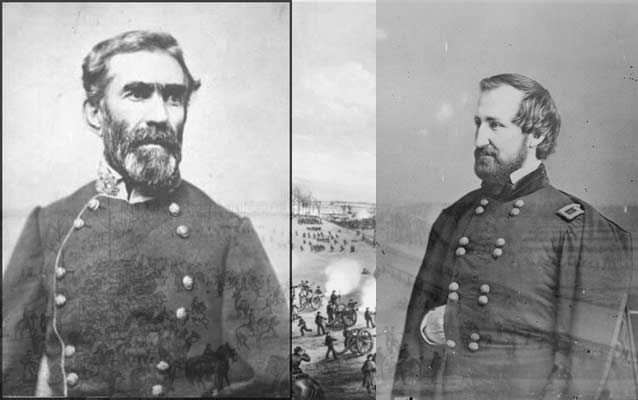Last updated: October 5, 2015
Lesson Plan
The Battle of Stones River: A Contrast in Leadership Styles

- Grade Level:
- High School: Ninth Grade through Twelfth Grade
- Subject:
- Social Studies
- Lesson Duration:
- 90 Minutes
- Common Core Standards:
- 9-10.RH.1, 9-10.RH.2, 9-10.RH.4, 9-10.RH.7, 9-10.RH.9, 11-12.W.1, 11-12.W.1.a
- State Standards:
- TN US Gov 6.0 (LE 6.1 & 6.2) / TN Sociology 4.0 (LE 4.2) / TN US History 4.0 / TN CTE-Ag. Leadership Communications 1.0 (LE 1.1, 1.2, 1.3, 1.4 & 1.5)
- Thinking Skills:
- Understanding: Understand the main idea of material heard, viewed, or read. Interpret or summarize the ideas in own words. Analyzing: Break down a concept or idea into parts and show the relationships among the parts.
Objective
1. Describe Leadership.
2. Explain the major types and styles of leaders.
3. Describe the Leadership types and styles of US Commanding General William S. Rosecrans and Confederate Commanding General Braxton Bragg at the Battle of Stones River.
4. Apply by Comparing and Contrasting how these types and styles of leadership demonstrated by Rosecrans and Bragg at the Battle of Stones River made a difference in the outcome of the battle.
Background
In this lesson plan, students will compare the leadership styles of Generals Braxton Bragg and William S. Rosecrans during their bloody confrontation at Stones River. Students will discover how to apply the seven habits of highly effective people to a historical event.
Preparation
Teachers may want to review the Source Documents ahead of time.
Materials
Download Source Document Excerpts - Contrast in Leadership Styles
Download 7 Habits of Highly Effective People Excerpt
Download 7 Habits of Highly Effective People Worksheet
Download Contrast the Generals Worksheet
Lesson Hook/Preview
Begin Class with Video Clip on Leadership: http://education-portal.com/academy/lesson/leadership-styles-and-types-authoritarian-laissez-faire-democratic.html
Reaction: After watching the video clip get student opinions on: Which type makes the best leader? Why??
Procedure
Step 1 - Lecture:
Write on board: "Leadership is _____________________."
A good leader does:
1. ___________________________________________.
2. ___________________________________________.
3. ___________________________________________.
Solicit student responses to information placed on board.
Step 2 - Teach Key Concepts and Vocabulary:
Pass out Leadership Primer and have students read the first page regarding Leadership terms and concepts.
Step 3 - Build Background Knowledge:
Ask students to evaluate differences between good leaders and bad leaders. Check board and evaluate the "Good Leader" list and ask class to change or add any characteristics.
Step 4 - Develop Understanding:
After reviewing the "Good Leader" list, create a "Bad Leader" list. Write on the board:
A bad leader does:
1. ___________________________________________.
2. ___________________________________________.
3. ___________________________________________.
Ask students: Which type of leader they would like to serve under?
Step 5 - Chart activity
To make sure students understand the main points of this lesson, teachers can assign a chart activity. Teachers have chart paper taped to various locations in the room with Leader Types at top of each (Authoritarian leader, Democratic leader, Expressive leader, Instrumental leader, and Laissez-faire leader.) Students will be divided into 5 different groups – Total Number of Student in Class divided by 5. Students will place descriptions regarding the Types of Leaders on each sheet. Groups will rotate for independent practice. After rotations, have a spokesperson from each group explain to the class why that type of leader is important.
Step 6 - Challenge with Reflection and Lesson Closure:
Students will complete the following question in a free-write: Describe the leadership characteristics of an ideal leader. Why does this make this particular leader effective? Cite examples from this lesson. They will also complete the assessment.
Vocabulary
Leader: Someone who influences other people.
Leadership styles: Ways in which people express their leadership.
Authoritarian leader: A leader who leads by giving orders.
Democratic leader: An individual who leads by trying to reach a consensus.
Expressive leader: An individual who increases harmony and minimizes conflict in a group; also known as a socioemotional leader.
Instrumental leader: An individual who tries to keep the group moving toward its goals; also known as a task-oriented leader.
Laissez-faire leader: An individual who leads by being highly permissive.
Assessment Materials
Which commanding general, William S. Rosecrans or Braxton Bragg, demonstrated better leadership qualities to impact the outcome of the Battle of Stones River? After reading selected excerpts from biographies of each general, excerpts from Stones River – Bloody Winter in Tennessee, additional primary source documents, as well as, summary information from Seven Habits of Highly Effective People by Steven Covey, write a newspaper or blog article that addresses the question and support your position with evidence from the text. This article/blog will be posted to a public source (Class Blog or Local Newspaper or School Student Newspaper) after grading; Student Portfolio /Notebook will be checked for minimum participation on this Section.
The teacher will use the CCSS Argumentative Rubric for scoring the completed newspaper article/blog. The Argumentative Rubric may be found at: http://tncore.org/sites/www/Uploads/TNCORE/Rubrics/OpArgRubric-Gr9-12-Literacy.pdf
Additional Resources
Texts: Source Packet with Primary Source Excerpts from the following sources:
Edge of Glory by William Lamers; Paperback: 520 pages; Publisher: Louisiana State University Press; Louisiana pbk. ed edition (May 1, 1999); Language: English; ISBN-10: 080712396X; ISBN-13: 978-0807123966.
General Braxton Bragg, C.S.A.by Samuel J. Martin; Hardback: 536 pages; Publisher: Publisher: McFarland & Company, Incorporated Publishers Publication date: 4/26/2011 Language: English; ISBN-13:. ISBN-13: 9780786459346.
Stones River – Bloody Winter in Tennessee by James Lee McDonough: Paperback: 286 pages; Publisher:University of Tennessee Press; 1 edition (January 31, 1983); Language: English; ISBN-10: 0870493736; ISBN-13:978-0870493737.
Videos:
Types of Leadership: http://education-portal.com/academy/lesson/leadership-styles-and-types-authoritarian-laissez-faire-democratic.html
Video Clip on Leadership during the Battle of Stones River: [TBD Video from Mike Browning.]
Video Clip on the Seven Habits of Highly Effective People:
https://www.youtube.com/watch?v=18qG-hDUzXA&safe=active
The Seven Habits of Highly Effective People Summary PowerPoint:http://www.slideshare.net/accountsdirect/leadership-and-7-habits-of-highly-effective-people
CCSS Argumentative Rubric for scoring the completed newspaper article/blog. The Argumentative Rubric may be found at: http://tncore.org/sites/www/Uploads/TNCORE/Rubrics/OpArgRubric-Gr9-12-Literacy.pdf
